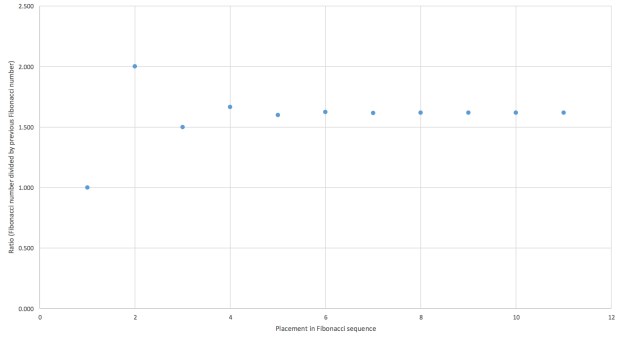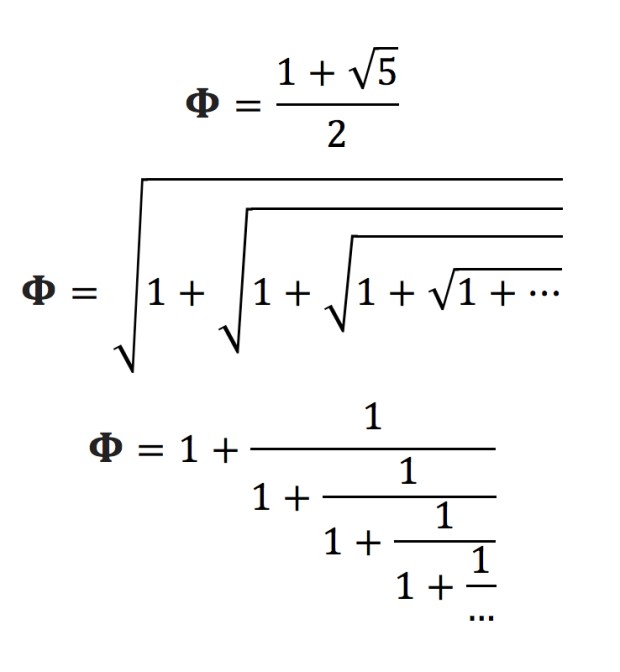Editor’s note: This article will be more fun if you’ve read Joel’s article on the Fibonacci sequence, which appeared in our last issue.
God has so many attributes and we, his children, have a few favorites that we enjoy focusing on. We describe his majesty, his glory, his loving kindness, his mercy, his grace, his love. But what do we call a Creator who seems to delight in uniting form and function into the same structure? What can we conclude when the processes involved in creation led to something both perfectly practical and breathtakingly beautiful at the same time? And what words might we use to describe a God who likes to use the same number over and over again in his creative work?
In my last article, I looked at Fibonacci sequence, a series that turns up frequently in creation:
1, 1, 2, 3, 5, 8, 13, 21, 34, 55, 89, 144…
We are going to take successive ratios of these Fibonacci numbers. Start with the first two numbers and divide them, then move to the second and third, then the third and fourth, and so on. For consistency’s sake, let’s round all answers to three decimal places.
1/1 = 1.000
2/1 = 2.000
3/2 = 1.500
5/3 = 1.667
8/5 = 1.600
13/8 = 1.625
21/13 = 1.615
34/21 = 1.619
55/34 = 1.618
89/55 = 1.618
144/89 = 1.618
Do you notice what is happening to the ratio? Follow the development of the answer to each division problem, starting at 1, moving to 2, then 1.5 and all the way to the last three in the sequence. What do you notice? A picture might help:

Rounded to three decimal places, the 9th through 11th quotients are identical, with small variations occurring only after the thousandths place. The quotients start to hone in on approximately the same value after we divide enough Fibonacci numbers. That number, much like the Fibonacci numbers themselves, has a unique role in nature and has earned itself a special name.
1.618 is the Golden Number.
Phi-Bonacci
This number actually has a bunch of gilded names, such as the golden ratio or the golden section or the golden mean. These names are all used when the number compared to 1, such as in the ratio 1:1.618. The number itself is more commonly referred to as phi (Φ), the 21st letter of the Greek alphabet.
Phi is, like pi, an irrational number, which means that you can’t obtain it exactly from a division problem of whole numbers the way we did. Our approach with the Fibonacci numbers only approximates the value of Phi, with each successive quotient getting closer and closer to the actual decimal value. There are a number of interesting (and even beautiful) equations to obtain phi. A sampling:

The first equation is the simplest. The second and third show two different but equally fascinating iterative formulas that, like the Fibonacci quotients, get closer and closer to phi with every completed iteration.
It is believed that it was the ancient Greeks who first used the term Golden Ratio to refer to the comparison 1.618:1. What caused them to hold it in such high esteem? Phi takes the Fibonacci numbers, prevalent in botany, and extends them to other parts of our natural world. Our entire planet is filthy with phi.
Phi in the face
You probably know your height in inches. But now measure the distance from the top of your head to where your fingertips end; be sure to measure this distance in a straight vertical line, not angled. Take a ratio of the two measurements; chances are it’s very close to 1.6. Find more people and measure all of their heights and all of their height-to-fingertip distances. Average all the ratios together. Chances are even better that it’s exactly 1.62. The more people you measure, the closer the ratios come to phi. We—meaning the members of the human race collectively—are built according to the Golden Ratio.
It doesn’t stop there. That height-to-fingertips measurement you took is a Golden Ratio to your height-to-navel distance. Which is a Golden Ratio of your height-to-collarbone. Which is a Golden Ratio of your height-to-chin. You get the idea. The bones in your fingers are Golden Ratios of each other. In your face alone there are no less than seven Golden Ratios; some experts argue that there are closer to a dozen. Certain plastic surgeons even execute their “plan of attack” according to phi. The further from phi your face is, the closer they try to approximate it during a cosmetic operation. Some of you are just thankful that now you can blame that ugly mug on mathematics as well as genetics. (Okay, fine, “some of us.”)
It’s almost as if the Golden Ratio (and, hence, the Fibonacci sequence) is built into our DNA. And quite literally, it is. The ratio of width to length of a single double helix in a strand of DNA is 1.619, accurate to one one-thousandths of a unit.
Humans aren’t the only species that exhibit phi. The head, thorax, and abdomen of many insects fall along perfect Golden Ratios. Animals with a variety of different markings (tiger stripes, spots on a moth, a penguin’s “tuxedo”) are divided along the Golden Ratio. Cycling back into botany (the focus of our look at the Fibonacci sequence), many plants have branches or stems that divide along the Golden Ratio.
Known without understanding
Humans have known about this ratio for centuries. There are examples from almost every culture where artists have demonstrated this knowledge by paying homage to the Golden Ratio in their creations. Notably, phi is key to the composition of the Pyramids of Egypt, the Greek Parthenon, da Vinci’s Last Supper and Vitruvian Man, Michelangelo’s The Creation of Man, Raphael’s The School of Athens, Seurat’s La Parade de Cirque, Notre Dame Cathedral in Paris, the Taj Mahal in Agra, and Mondrian’s Tableau 1.
There are even a number of examples of humans’ latent use of the Golden Ratio. Find a sample of your handwriting and locate a capital “E”. It’s a safe assumption that the distance between the top line and middle line is not the same as the distance between the middle line and bottom line. We don’t tend to “center” our mid-line in a capital E. There’s a really good chance the ratios of the distances is 1.6:1. How many of us draw the two “bumps” in our capital “B” the same size? Instead, we most often draw them in the Golden Ratio to one another. Phi is not just our preference when viewing created works; Phi is our tendency when employing a creative process.
Whereas the Fibonacci numbers are used for efficiency and energy conservation in plants, the Golden Ratio seems to have a connection to the aesthete in each of us. What has been less clear over the centuries is why exactly we have an aesthetic preference for artifacts that utilize phi. It’s not just about survival; it’s about beauty. It’s not just about efficiency; it’s about appeal.
Scientists theorize that perhaps the “appeal” of phi and the efficiency of the Fibonacci sequence go hand-in-hand. Our most primal state, the one that wants to give our genes the highest chance of survival going forward, is very possibly drawn to specimens that demonstrate an understanding and utilization of the very system that makes survival more likely.
This is an article in a Christian magazine. So this is where you’re probably expecting it to pivot to Golden Ratios in the Bible. Many have tried to squeeze the ratio out of the dimensions of the Ark of the Covenant, Noah’s Ark, or Solomon’s Temple. None of those ratios is very far from 1.618:1. But none is particularly close, either. What’s amazing isn’t the potential for hidden codes and clues in Scripture but that God has plainly given us this ratio in his natural revelation.
I thought about the Fibonacci numbers and phi a lot while reading Job 38–42 recently. Job’s friends spent dozens of chapters telling Job why he’s being punished. They felt they had a full understanding of who God is and why he does what he does. God, however, feels otherwise; he reflects on his creation and asks how well Job really understands God.
Does reflecting on the Fibonacci numbers and phi in creation tell us anything about God? Might our Creator delight in a system in uniting aesthetics and practical efficiency in a complex relationship? Surely. “He has made everything beautiful in its time” (Ecc. 3:11). But we can quickly fall into more dangerous conclusions. The penguin whose tuxedo best displays the Golden Ratio is not the most delightful to God. Phi-friendly faces are not more godly. God has told us what he finds beautiful, what he delights in, and it has nothing to do with physical ratios. Obedience, justice, uprightness, seeking God—these don’t lend themselves to ratios.
Similarly, when God asks Job about being able to “satisfy the hunger of the lions” (Job 38:39), he’s not making a point about animal predation. He’s talking about his own provision—a sign of his wisdom and power. Job’s friends have one calculus: sins equal woes. If you’re experiencing many woes, they calculate, you must have committed many sins. Job has a slightly different calculus: He adds up his righteous deeds, subtracts his wrongdoings, and concludes that he was wronged: he should have experienced blessings instead of curses. God’s response is that their calculators are too small, that their math is altogether wrong, that their language is “words without knowledge.” “Have you entered the storehouses of the snow?” he asks. This is the question from God I hear, too, when I think about the Fibonacci numbers. Did you arrange the plants so they could maximize their use of energy? Did you do so with a ratio that the whole world would find beautiful? Are you able to unite form and function like this?
My answer can only be Job’s: “Surely I spoke of things I did not understand, things too wonderful for me to know.”
This is the second of three articles in a series on Fibonacci numbers in nature.












